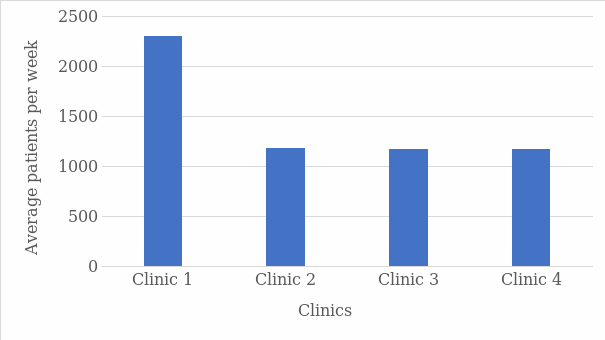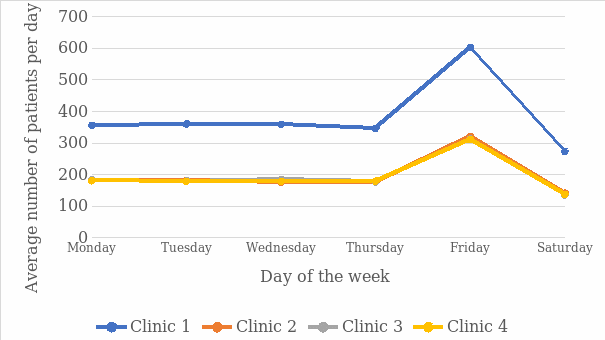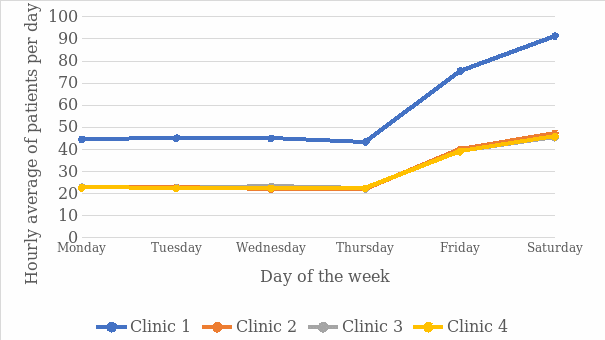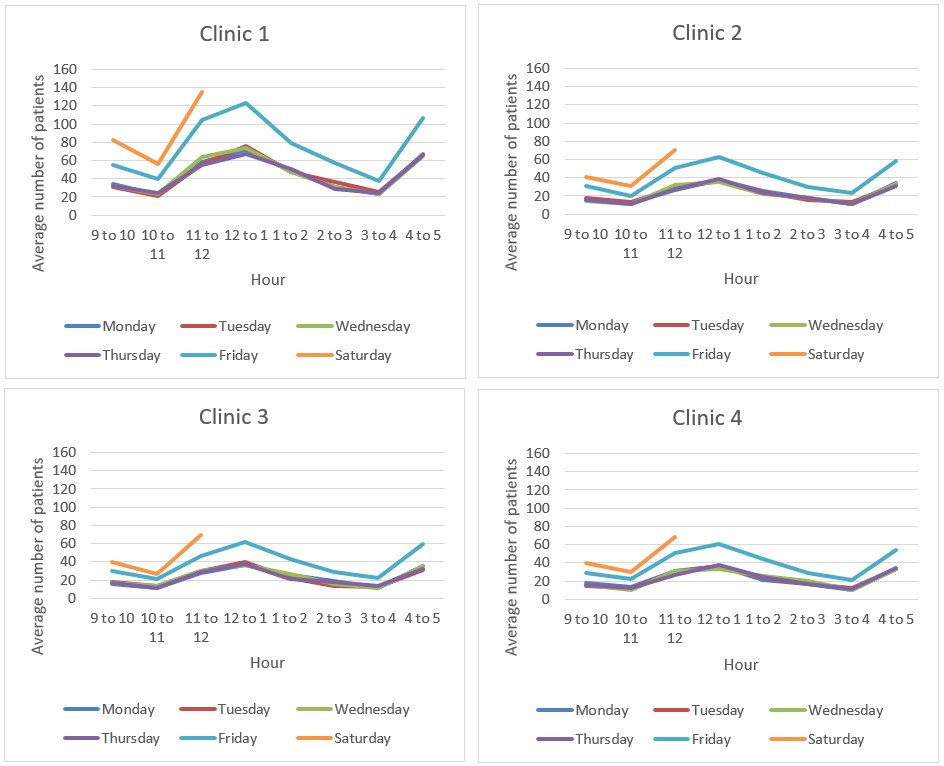Introduction
Covenant Hospital medical facility’s primary mission statement is offering its clients high-quality care and safety. Notably, one of the core variables utilized in assessing the standard of the healthcare center is the patient’s waiting time, particularly from the period they arrive at the institution until a medical practitioner attends them (Al-Harajin et al., 2019). The Covenant Hospital’s manager must minimize the client’s wait time and enhance healthcare quality. Nevertheless, the corporate leader should plan an optimal strategy to attain such goals. Therefore, the manager should comprehensively comprehend the time of the week when there is significant traffic of patients to every of the Covenant Hospital’s four clinics. Proper reengineering of hospitals has a positive impact, including reducing long waiting times and lowering overcrowding of patients, resulting in improved healthcare service delivery.
Analysis of Customer Traffic and Pattern

Collecting data regarding the patient arrival pattern is essential to determine client traffic. The medical facility’s management has gathered a database concerning the total number of clients arriving at the four clinics hourly over ten weeks. The results from the analysis of Charts will help the manager design a feasible scheme to reduce the waiting time, resulting in improved client contentment and the standard of services offered at Covenant Hospital. Figure 1 contrasts the number of patients arriving in Covenant Hospital’s four clinics. Compared to other units, clinic 1 has an average number of patients above 2000. As a result, the healthcare center manager must reduce clinic 1 waiting time to enhance the quality of care. At the same time, there is a high number of clients at the other three clinics; therefore, the manager could similarly apply the policy to them.


Figure 2 illustrates the daily discrepancy of the total customer traffic in all four Covenant Hospital clinics. From Monday to Saturday, clinic 1 has the highest number of average clients per day compared to the other three units. In addition, Friday records the high number of patients at all four clinics, with unit 1 having the highest patient traffic. On the other hand, figure 3 showcases the hourly average of customers arriving at every clinic on each week day. Since most people are free from work, all four clinics have the highest customer traffic per hour, mainly on Fridays and Saturdays. Nevertheless, clinic 1 has increased hourly patient traffic, contrasted with clinics 2, 3, and 4. Compared to any other day of the week, the issues related to the massive assistance of clients are high on Saturdays since the facility ceases its operations. The increased customer traffic indicates an escalated level of poor service delivery, leading to deteriorated patient satisfaction.

Figure 4 illustrates the hourly sequence of the number of customers arriving at different Covenant Hospital clinics. From Monday to Saturday, the number of patients tends to increase from 10.00 am to 1.00 pm and from 3.00 pm to 5.00 pm in all four clinics. However, for all the clinics, the peak hours are from 12.00 noon to 1.00 pm and 4.00 pm to 5.00 pm from Monday to Saturday. In addition, all the Saturdays record high arrival of patients in all four clinics, mainly from 10.00 am to 12.00 noon. Notably, there is a substantial similarity between the hourly patterns from Monday to Thursday in all four clinics. The increased hourly sequence of customers arriving at different units at Covenant Hospital indicates an escalated poor service delivery, resulting in client dissatisfaction.
Recommendations/Suggestions
From the analysis of the results, I suggest various recommendations that Covenant Hospital’s management must implement at all four clinics to minimize waiting time, ensuring high-quality healthcare service delivery to patients. Firstly, the executive team must expand the opening hours, mainly on Saturdays, to alleviate overcrowding of patients in the three hours the facility remains open (Godley & Jenkins, 2019). Secondly, the hospital executive must ensure that the patients know that they offer similar services at clinics 2, 3, and 4 to minimize congestion at clinic 1. Lastly, the management must hire more staff members on Fridays and Saturdays to curb the increased customer demand for services.
Conclusion
Covenant Hospital healthcare center’s primary mission is to offer its customers high-quality care and safety. There is an increased number of patients arriving at clinic 1 compared to the other three medical facilities. Saturdays record high arrival of patients in all four clinics, mainly from 10.00 am to 12.00 noon, even though it has minimal operational hours. For all the clinics, the peak hours are from 12.00 noon to 1.00 pm and 4.00 pm to 5.00 pm from Monday to Saturday. Covenant Hospital management must employ more subordinates to cater to the increased number of patients, mainly on Fridays and Saturdays. The escalated client traffic showcases an increased level of poor service delivery, resulting in decreased patient contentment.
References
Al-Harajin, R. S., Al-Subaie, S. A., & Elzubair, A. G. (2019). The association between waiting time and patient satisfaction in outpatient clinics: Findings from a tertiary care hospital in Saudi Arabia. Journal of Family & Community Medicine, 26(1), 17. Web.
Godley, M., & Jenkins, J. B. (2019). Decreasing wait times and increasing patient satisfaction: a lean six sigma approach. Journal of Nursing Care Quality, 34(1), 61-65. Web.